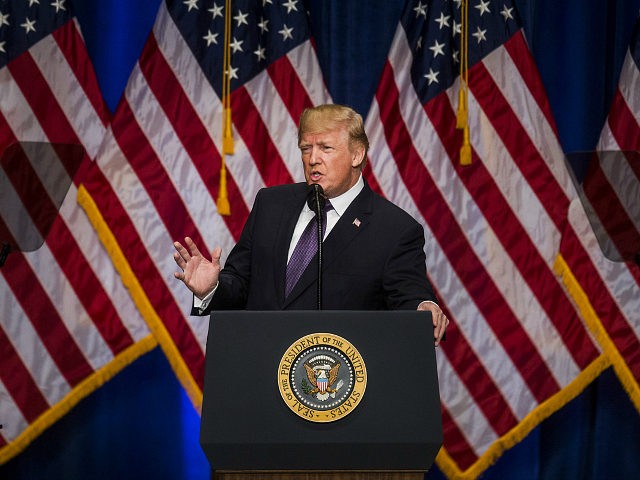Defense hawks in Washington hailed President Trump’s National Security Strategy (NSS), which called for overturning the defense sequester and modernizing and building up the military.
Trump unveiled the strategy during a speech at the Ronald Reagan Building on Monday. It called for a “total modernization” of the military, reversing previous decisions to reduce its size, streamlining the weapons-buying process, eliminating “bloated bureaucracy,” and building up the defense industrial base.
It also called for countering modern threats, including cyber and electromagnetic attacks. It called for shoring up U.S. defense in space and a “multi-layered missile defense.”
It was unveiled to mostly sniping by the foreign policy establishment critics in Washington, but lawmakers and experts who support a strong military gave rave reviews.
“The president’s national-security strategy is a clear-eyed assessment of the threats we face and what it will take to confront them. I also applaud the president for committing to rebuild our military,” said Senate Armed Services Committee member Sen. Tom Cotton (R-AR).
Sen. Jim Inhofe (R-OK), another committee member, said the NSS charted “a new course” for American foreign policy: “President Trump’s bold national security strategy leaves little question that he is charting a new course for American foreign policy, leaving behind the failed policies of President Obama.”
Another Armed Services Committee member, Sen. David Perdue (R-GA), said the new strategy will “encourage diplomacy with our allies and challenge our global competitors.”
“Under the direction of President Trump, America is signaling a strong commitment to reengaging as a global and economic leader,” he said.
The strategy also received praise from defense experts, including some who did not support Trump.
“I come away impressed and satisfied. There are some nits to pick, but as I consider what it actually says – and how it differs from what precedes it – I am generally supportive of it,” said Bryan McGrath, naval expert and retired Navy commander.
Jerry Hendrix II at the Center for a New American Security, a centrist think-tank that leans left, praised the new strategy, calling it a “new path” that focuses on investing in cutting-edge technologies, growing the force, and improving readiness.
“Clearly, President Trump’s commitment to a 355-ship Navy falls within this approach,” he added. “The president also firmly commits the nation to recapitalizing the nation’s nuclear-deterrent force and renewing all three legs of the nuclear triad.”
He also noted the strategy “provides a deep focus on the nation’s defense-industrial base,” renewing the defense manufacturing sector, and avoiding relying on foreign supplies for key components. And he called it refreshing that the NSS mentioned space as a “priority domain.”
However, he noted that the strategy would be enabled by “increased defense spending” from Congress – a point defense hawks in the House echoed.
House Armed Services Committee chairman Rep. Mac Thornberry (R-TX) called the NSS “a good start” but said only “sufficient funding for our military can make it real.”
Rep. Mike Turner (R-OH), chairman of the panel’s Tactical Air and Land Forces Subcommittee, urged colleagues to “fully fund” national defense after Trump unveiled the NSS.
“Expecting our military to successfully operate on a system of fictional and unreliable budgeting is incredibly irresponsible,” he said in a comment directed to fiscal hawks and Democrats.
“A vote against funding what we have already promised our troops would be playing politics with their lives. I encourage both the House and Senate to take swift action to rebuild our readiness,” he said.
Defense hawks want $700 billion in defense, $66 billion more than was appropriated last year. Trump has called for reduced spending in non-defense, but Democrats, who can filibuster a defense spending bill in the Senate, will insist on matching increases in the defense budget with higher spending on non-defense.
How much the Pentagon will actually have will depend on a spending deal reached in Congress, likely early next year.
A 2018 government funding bill was due by October 1, but the government has since been operating on short-term spending measures known as a continuing resolution.
Congress will likely pass another short-term spending measure through January, when lawmakers will try to take another stab at a spending bill.
But for now, Republicans are heartened by Trump’s determination to rebuild the military.
“After eight years of neglect, there’s much we need to do, but I’m confident the president is determined to build the best-trained, the best-equipped, and the best-led military in the world.”

COMMENTS
Please let us know if you're having issues with commenting.